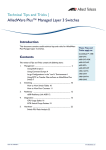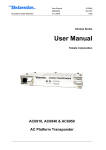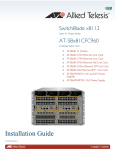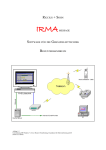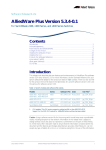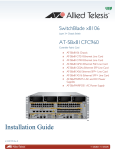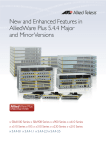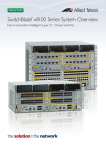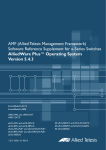Download Allied Telesis 48Ts/X Specifications
Transcript
Software Release Note AlliedWare Plus Version 5.4.3-0.1 For SwitchBlade x8112, SwitchBlade x908, x900, x610 and x510 Series Switches Contents Introduction ................................................................................................................................................. 2 Acknowledgements .................................................................................................................................. 3 Hardware Support ..................................................................................................................................... 4 Support for x510 Series Switches.................................................................................................. 4 Support for SwitchBlade x8112 Next Generation Intelligent Layer 3+ Chassis Switch........................................................................................................................... 4 Support for XEM-12Tv2 and XEM-12Sv2 modules ................................................................. 6 New Features and Enhancements ....................................................................................................... 7 IPv6 Enhancements............................................................................................................................ 7 IPv6 Licensing ...................................................................................................................................... 8 Stacking Enhancements................................................................................................................... 8 Energy Efficient Ethernet (EEE) Support ..................................................................................... 8 Find Me................................................................................................................................................... 8 Important Considerations Before Upgrading to this Version .................................................... 9 Changes in this Version..........................................................................................................................10 Installing this Software Version ..........................................................................................................25 Installing the GUI......................................................................................................................................26 C613-10508-01-REV B Software Release Note AlliedWare Plus Version 5.4.3-0.1 1 Introduction This release note describes the new features and enhancements in AlliedWare Plus software version 5.4.3-0.1 since version 5.4.2-0.1. For more information, see the Software Reference for your switch. Software file details for this version are listed in Table 1 below. Table 1: Switch models and software file names Models Series Software File GUI File Date x510-28GTX x510-52GTX x510 x510-5.4.3-0.1.rel x510-gui_543_10.jar 03/2013 x610-24Ts x610-24Ts-PoE+ x610-24Ts/X x610-24Ts/X-PoE+ x610-24SPs/X x610-48Ts x610-48Ts-PoE+ x610-48Ts/X x610-48Ts/X-PoE+ x610 x610-5.4.3-0.1.rel x610-gui_543_09.jar 03/2013 x900-12XT/S x900-24XS x900-24XT x900 x900-5.4.3-0.1.rel x900-gui_543_09.jar 03/2013 SwitchBlade x908 SBx908 SBx908-5.4.3-0.1.rel x900-gui_543_09.jar 03/2013 SwitchBlade x8112 SBx8112 SBx81CFC400-5.4.3-0.1.rel SBx81CFC400_gui_543_07.jar 03/2013 Caution: Using a software version file for the wrong switch model may cause unpredictable results, including disruption to the network. Information in this release note is subject to change without notice and does not represent a commitment on the part of Allied Telesis, Inc. While every effort has been made to ensure that the information contained within this document and the features and changes described are accurate, Allied Telesis, Inc. can not accept any type of liability for errors in, or omissions arising from, the use of this information. 2 Software Release Note AlliedWare Plus Version 5.4.3-0.1 C613-10508-01-REV B Acknowledgements This product includes software developed by the University of California, Berkeley and its contributors. Copyright ©1982, 1986, 1990, 1991, 1993 The Regents of the University of California. All rights reserved. This product includes software developed by the OpenSSL Project for use in the OpenSSL Toolkit (http://www.openssl.org/). Copyright ©1998-2008 The OpenSSL Project. All rights reserved. This product includes software licensed under the GNU General Public License available from: http://www.gnu.org/licenses/gpl2.html Source code for all GPL licensed software in this product can be obtained from the Allied Telesis GPL Code Download Center at: http://www.alliedtelesis.com/support/default.aspx Allied Telesis is committed to meeting the requirements of the open source licenses including the GNU General Public License (GPL) and will make all required source code available. If you would like a copy of the GPL source code contained in Allied Telesis products, please send us a request by registered mail including a check for US$15 to cover production and shipping costs and a CD with the GPL code will be mailed to you. GPL Code Request Allied Telesis Labs (Ltd) PO Box 8011 Christchurch. New Zealand ©2013 Allied Telesis, Inc. All rights reserved. This documentation is subject to change without notice. No part of this publication may be reproduced, stored in a retrieval system, or transmitted in any form or any means electronic or mechanical, including photocopying and recording for any purpose other than the purchaser’s internal use without the written permission of Allied Telesis, Inc. Allied Telesis, AlliedWare Plus, EPSRing, SwitchBlade, and VCStack are trademarks or registered trademarks in the United States and elsewhere of Allied Telesis, Inc. Adobe, Acrobat, and Reader are either registered trademarks or trademarks of Adobe Systems Incorporated in the United States and/or other countries. Additional brands, names and products mentioned herein may be trademarks of their respective companies. C613-10508-01-REV B Software Release Note AlliedWare Plus Version 5.4.3-0.1 3 Hardware Support This version provides the following new hardware support. Support for x510 Series Switches The Allied Telesis x510 family of switches provide a high performing and scalable solution for today’s networks, providing an extensive range of port density and uplink-connectivity options. With a choice of 28-port and 52-port versions and optional 10 Gigabit uplinks, plus the ability to stack, the x510 family can connect anything from a small workgroup to a large business. Table 2: x510 switch models and port specifications 10/100/1000T (RJ-45) Copper Ports 100/1000 BASE-X SFP Ports 1/10 Gigabit SFP+ Ports 10 Gigabit Stacking Ports x510-28GTX 24 – 2 2* x510-52GTX 48 – 2 2* Product * Stacking ports can be configured as additional 10G Ethernet ports when a unit is not stacked. For more information on the x510 Series switches, see the x510 Data Sheet, Installation Guide and the Software Reference. These documents are available from our website at www.alliedtelesis.com/switches/x510. Support for SwitchBlade x8112 Next Generation Intelligent Layer 3+ Chassis Switch The SwitchBlade x8112 is a 12-slot Next Generation Intelligent Layer 3+ chassis switch designed to deliver high availability, wire-speed performance, and a high port count. Allied Telesis advanced features make it the ideal solution for the modern enterprise network where resiliency, reliability, and high performance are the key requirements. The Allied Telesis SwitchBlade x8112 is a high performing scalable solution, providing an extensive range of connectivity options. Dual control cards are partnered with 10 line card slots. Gigabit and 10 Gigabit line card options ensure a system capable of meeting the requirements of today’s networks, and the flexibility to expand when required. SwitchBlade x8112 is a 7-rack unit modular chassis comprising: 4 ■ Controller Fabric Card (CFC) slots x2 ■ Line card slots x10 ■ System PSU bays x2 ■ Power over Ethernet (PoE) PSU bays x2 ■ Fan tray Software Release Note AlliedWare Plus Version 5.4.3-0.1 C613-10508-01-REV B SwitchBlade x8112 key features ■ Dual CFCs are partnered with 10 line card slots ■ 80Gbps non-blocking throughput to each line card slot ■ Active-Active switching fabric utilizes all available system bandwidth, and fast failover is provided with the second control card in hot-standby. ■ Supports IEEE 802.3at PoE+ (30W): two additional PoE PSUs can be installed to maximize power available to connected devices ■ Designed to reduce power consumption (high efficiency power supplies and low power chip sets) and minimize hazardous waste ■ An ECO-Switch button on the front panel allows conservation of additional power by turning off all diagnostic LED indicators when they are not required For information about the AlliedWare Plus features on SwitchBlade x8112, see the AlliedWare Plus Software Reference for SwitchBlade x8100 Series Switches. SwitchBlade x8112 Controller Fabric Card (CFC) ■ SBx81CFC400 controller fabric card provides 40Gbps bandwidth per line card slot (80 Gbps with 2 control cards) ■ 80Gbps x 10 line card slots = 800Gbps per system ■ RS-232 and Ethernet management port for out of band management ■ USB connector for external file transfer and storage ■ Centralised LEDs provide status of all 12 card slots, CFC, PSU, fan tray SwitchBlade x8112 Line Cards ■ SBx81GT24 Line Card with 24 x 10/100/1000T ports ■ SBx81GP24 Line Card with 24 x 10/100/1000T PoE+ ports ■ SBx81GS24a Line Card with 24 x 100/1000 SFP ports ■ SBx81XS6 Line Card with 6 x 10Gbps SFP+ ports PSUs and Fan Tray The switch uses high efficiency power supplies. Each power supply can be fed from a separate power source to increase reliability. ■ SBxPWRSYS1 (1200W AC System Power Supply) The switch operates with one system PSU, and installing a second loadsharing PSU provides ultimate redundancy. ■ SBxPWRPOE1 (1200W AC PoE Power Supply) Two PoE PSUs can be installed to maximize power available to connected devices. ■ SBxFAN12 (Fan tray for 12 slot chassis) The PSUs and the fan tray are all hot-swappable to maximise uptime during maintenance or reconfiguration. For more information about the hardware, see the SwitchBlade x8112 Installation Guide. These documents are available from our website at www.alliedtelesis.com/switches/ sbx8112. C613-10508-01-REV B Software Release Note AlliedWare Plus Version 5.4.3-0.1 5 Support for XEM-12Tv2 and XEM-12Sv2 modules ■ XEM-12Tv2 provides 12x 10/100/1000T (RJ-45) ports for copper cabling ■ XEM-12Sv2 provides 12x 1000X SFP ports for fiber cabling XEM-12Tv2 and XEM-12Sv2 modules support Extended Mode, the SwitchBlade x908 feature that increases the performance of the SwitchBlade x908. Extended Mode takes advantage of larger table sizes and Link Aggregation Groups. The following table describes the increases in system limits when you enable Extended Mode: SwitchBlade x908 Standard Mode SwitchBlade x908 Extended Mode MAC entries 16K 64K Nexthops 2.5K 8K QoS Traffic Classes 713 4,096 Link Aggregation Groups 31 128 1,024 4,096 Access Control Lists Extended Mode for SwitchBlade x908 switches is supported on XEM-2XP, XEM-2XT, XEM-2XS, XEM-12Tv2, and XEM-12Sv2 modules. Extended Mode for SwitchBlade x908 switches is not supported on XEM-1XP, XEM-12T, or XEM-12S modules. For more information about configuring Extended Mode for SwitchBlade x908 switches, see the platform silicon-profile command in the Switching Commands chapter of the AlliedWare Plus Software Reference for SwitchBlade x908 Switches and x900 Series Switches. For more information on the XEM-12Tv2 and XEM-12Sv2 modules, see the x900 Series Switch and SwitchBlade x908 Expansion Module Installation Guide and the x900 Series Switch and SwitchBlade x908 Hardware Reference. These documents are available from our website at www.alliedtelesis.com/switches. 6 Software Release Note AlliedWare Plus Version 5.4.3-0.1 C613-10508-01-REV B New Features and Enhancements The software version includes all the new features that have been added to AlliedWare Plus since the release of 5.4.2-0.1. This includes all features that were released in 5.4.2 minor releases. This section summarizes the key new features. For a list of all new and enhanced features and commands, see “Changes in this Version” on page 10. For more information about all features on the switch, see the Software Reference for your switch. Unless otherwise stated, all new features and enhancements are available on all switch models running this version of AlliedWare Plus. IPv6 Enhancements PIM-SMv6 Software version 5.4.3 adds support for Protocol Independent Multicast - Sparse Mode for IPv6. PIM-SMv6 provides efficient communication between members of sparsely distributed groups in PIM-SM IPv6 networks. MLD Software version 5.4.3 expands the Alliedware plus support for Multicast Listener Discovery (MLD). MLD is the IPv6 equivalent of the Internet Group Management Protocol (IGMP) for IPv4. It is used by IPv6 routers to discover the presence of multicast listeners on their directly attached links and to discover which multicast addresses are of interest to those listeners. This ensures that multicast traffic is forwarded as efficiently as possible, conserving network bandwidth. AlliedWare Plus now supports both MLDv1 and MLDv2. Previous releases supported MLD Snooping functionality. This release now supports MLDv2 Querier functionality. Static IPv6 Multicast Routes Software version 5.4.3 adds the ability to create static IPv6 multicast forwarding entries. Rather than relying on a dynamic multicast routing protocol like PIM to set up L3 multicast entries, it is possible to create the entries statically. Static IPv6 Multicasting has been added as a base license feature for AlliedWare Plus version 5.4.3. DHCPv6 Software version 5.4.3 adds support for Dynamic Host Configuration Protocol (DHCPv6), which is a protocol used to dynamically assign IPv6 addresses to hosts from a central location. Acting as DHCPv6 client enables the switch to receive an IPv6 address, and acting as server enables the switch to dynamically allocate IPv6 addresses to hosts. The DHCPv6 server and client both support the Prefix Delegation feature which allocates a whole IPv6 subnet to a DHCP client. The client, in turn, can allocate addresses from this subnet to the hosts that are connected to it. OSPFv3 Authentication/Confidentiality Software version 5.4.3 adds support for OSPFv3 authentication and confidentiality, which enable the secure sharing of routing information by encrypting OSPFv3 messages. VRRPv3 Software version 5.4.3 adds support for Virtual Router Redundancy Protocol for IPv6 networks, by implementing VRRPv3. VRRPv3 is a protocol for providing device redundancy, for connecting redundant WAN gateway routers or server access switches. It allows a backup router or switch to automatically take over if the primary (master) router or switch fails. C613-10508-01-REV B Software Release Note AlliedWare Plus Version 5.4.3-0.1 7 IPv6 Licensing As IPv6 functionality has become more of a necessity in modern networks, Allied Telesis has increased our support by including a number of IPv6 features as standard (additional advanced IPv6 features are available via a software license). The IPv6 features included as standard on Allied Telesis switches are: ■ IPv6 unicast traffic forwarding ■ Telnet, Ping, Traceroute for IPv6 ■ SSHv6 ■ SNMPv6 ■ IPv6 static routes ■ DHCPv6 relay ■ NTPv6 ■ RA Guard ■ DNSv6 ■ SLAAC ■ IPv6 static multicast routes Stacking Enhancements Software version 5.4.3 fully supports the maximum number of ports available on 8 unit VCStack x610 solutions (384 ports). This has increased from 208 ports previously. Configuration restrictions imposed by previous releases are now removed. Note: Mixed-mode stacking between x610 and x600 series switches is not supported because Software version 5.4.3 does not support x600 switches. Energy Efficient Ethernet (EEE) Support Software version 5.4.3 adds support for IEEE 802.3az EEE which is a specification for lowering power consumption of Ethernet PHYs during periods of low link utilisation. If no data is being sent, the PHY can either slow down the link speed or it can enter a sleep state, called Low Power Idle (LPI), to save power. Find Me Software version 5.4.3 adds support for “Find Me”. In busy server rooms comprising of a large number of equipment racks, it can be quite a job finding the correct switch quickly among many similar units. The ‘Find Me” feature is a simple visual way to quickly identify the desired physical switch for maintenance or other purposes, by causing its LEDs to flash in a specified pattern. 8 Software Release Note AlliedWare Plus Version 5.4.3-0.1 C613-10508-01-REV B Important Considerations Before Upgrading to this Version Please note the following information that may affect you if you are upgrading to Software version 5.4.3 from an earlier version: ■ Software version 5.4.3 does not support x600 series switches. ■ Software version 5.4.3 does not support mixed-mode stacking between x610 series switches and x600 series switches, because all switches in the stack must run the same software version. Software version 5.4.2 is the latest version you can run on a mixed mode stack. C613-10508-01-REV B Software Release Note AlliedWare Plus Version 5.4.3-0.1 9 Changes in this Version Table 3 below lists new and modified features in this version. Table 4 on page 11 below lists all new and modified commands in this version and shows which chapter of the Software References has details of each command. Table 5 below lists new and modified SNMP (Simple Network Management Protocol) MIBs (Management Information Bases) in this version. Status x610 x900 x908 DHCPv6 New Y Y Y Y Eco-Friendly New Y N Find Me New MLD x8112 Feature/MIB x510 Table 3: New and modified features in 5.4.3 Software Reference Chapter Description Y DHCP for IPv6 (DHCPv6) Introduction and Configuration Alliedware Plus supports Dynamic Host Configuration Protocol (DHCPv6) which is a protocol used to dynamically assign IPv6 addresses to hosts from a central location. Acting as a DHCPv6 client enables the switch to receive an IPv6 address, and acting as server enables the switch to dynamically allocate IPv6 addresses to hosts. The DHCPv6 server and client both support the Prefix Delegation feature which allocates a whole IPv6 subnet to a DHCP client. The client, in turn can allocate addresses from this subnet to the hosts that are connected to it. N N Y Getting Started You can now conserve power by enabling the eco-friendly LPI (Low Power Idle) feature either by entering the ecofriendly lpi command or by pressing the eco-friendly button on the front panel. This feature reduces the power supplied to the ports by the switch whenever the ports are idle and are connected to IEEE 802.3az Energy Efficient Ethernet compliant host devices. Y N Y Y N Getting Started The Find Me feature enables you to physically locate a specific device from a group of similar devices. New Y Y Y Y Y MLD and MLD Snooping Introduction and Commands AlliedWare Plus supports Multicast Listener Discovery (MLD and MLDv2). MLD is defined in RFC2710. MLDv2 is defined in RFC 3810. MLD for IPv6 is used to exchange membership status information between hosts and routers that support multicasting. OSPFv3 New Authentication and Encryption N Y Y Y Y OSPFv3 for IPv6 Introduction and Configuration AlliedWare Plus supports Open Shortest Path First (OSPFv3) Authentication as specified in RFC4552. Message Digest Algorithm 5 (MD5) and Secure Hash Algorithm 1 (SHA-1) Authentication algorithms are supported in the AlliedWare Plus implementation of OSPFv3 Authentication. Advanced Encryption Standard (AES) and Triple Data Encryption Standard (3DES) Encryption algorithms are supported. PIM-SMv6 Y Y Y Y Y PIM-SMv6 Introduction and Configuration Protocol Independent Multicast - Sparse Mode for IPv6 (PIM-SMv6) provides efficient communication between members of sparsely distributed groups. 10 New Software Release Note AlliedWare Plus Version 5.4.3-0.1 C613-10508-01-REV B Feature/MIB Status x610 x900 x908 Software Reference Chapter x510 x8112 Table 3: New and modified features in 5.4.3 Static IPv6 Multicast Routes New Y Y Y Y Y Multicast Introduction and Commands Rather than having to rely on a dynamic multicast routing protocol such as PIM to set up L3 multicast entries, you can now create these entries statically. VRRPv3 New Y Y Y Y Y VRRP Introduction and Configuration The VRRPv3 defined in RFC 5798 for IPv4 and IPv6 combines two or more physical switches into a logical grouping called a virtual router (VR). The physical switches then operate together to provide a single logical gateway for hosts on the LAN. Description If your existing configurations include commands modified or deprecated in this version (see the Status column), check whether you need to modify these configurations. For full command descriptions, modes and examples, see the appropriate Software Reference for your switch. x900 x908 x8112 Status x510 Software Reference Chapter Command address prefix New Y Y Y Y Y DHCP for IPv6 (DHCPv6) Commands Use this command to specify an address prefix for address assignment with DHCPv6 server pool configuration. address range New Y Y Y Y Y DHCP for IPv6 (DHCPv6) Commands Use this command to specify an address range for address assignment with DHCPv6 server pool configuration. clear counter ipv6 dhcpclient New Y Y Y Y Y DHCP for IPv6 (DHCPv6) Commands Use this command in Privileged Exec mode to clear DHCPv6 client counters. clear counter ipv6 dhcpserver New Y Y Y Y Y DHCP for IPv6 (DHCPv6) Commands Use this command in Privileged Exec mode to clear DHCPv6 server counters. clear ipv6 dhcp New binding Y Y Y Y Y DHCP for IPv6 (DHCPv6) Commands Use this command to clear all dynamic lease bindings, or lease bindings specified in the command. The command will only take effect on dynamically allocated bindings, not statically configured bindings. This command clears binding entries on the DHCPv6 server binding table. clear ipv6 dhcp New client Y Y Y Y Y DHCP for IPv6 (DHCPv6) Commands Use this command in Privileged Exec mode to restart a DHCPv6 client on an interface. dns-server New Y Y Y Y Y DHCP for IPv6 (DHCPv6) Commands Use this command to add an IPv6 address for a Domain Name System (DNS) server to the DHCPv6 address pool you are configuring. domain-name New Y Y Y Y Y DHCP for IPv6 (DHCPv6) Commands Use this command to add a domain name to the DHCPv6 server address pool you are configuring. ipv6 address New Y Y Y Y Y DHCP for IPv6 (DHCPv6) Commands Use this command in Interface Configuration mode for a VLAN interface to add an IPv6 address to the IPv6 prefix provided by a DHCPv6 Prefix Delegation server. C613-10508-01-REV B x610 Table 4: New and modified commands in 5.4.3 Description Software Release Note AlliedWare Plus Version 5.4.3-0.1 11 x900 x908 x8112 Status x510 Software Reference Chapter Command ipv6 address dhcp New Y Y Y Y Y DHCP for IPv6 (DHCPv6) Commands Use this command to activate the DHCPv6 client on the interface that you are configuring. This allows the interface to use the DHCPv6 client to obtain its IPv6 configuration details from a DHCPv6 server on its connected network. ipv6 dhcp client pd New Y Y Y Y Y DHCP for IPv6 (DHCPv6) Commands Use this command in Interface Configuration mode to enable the DHCPv6 client process and enable requests for prefix delegation through the interface that you are configuring. ipv6 dhcp option New Y Y Y Y Y DHCP for IPv6 (DHCPv6) Commands Use this command to create a user-defined DHCPv6 option. You can then use this option when configuring a DHCPv6 server address pool, by using the option command. ipv6 dhcp pool New Y Y Y Y Y DHCP for IPv6 (DHCPv6) Commands Use this command to enter the configuration mode for the DHCPv6 server pool name specified. If the name specified is not associated with an existing pool, the switch will create a new pool with this name, then enter the configuration mode for the new pool. ipv6 dhcp server New Y Y Y Y Y DHCP for IPv6 (DHCPv6) Commands Use this command in Interface Configuration mode to enable DHCPv6 server for the current IPv6 configured interface to use the specified DHCPv6 server pool name. ipv6 local pool New Y Y Y Y Y DHCP for IPv6 (DHCPv6) Commands Use this command in Global Configuration mode to configure a local DHCPv6 server prefix delegation pool specifying a pool name and a prefix/prefix length. You can optionally exclude the locally assigned prefix from the pool with the exclude-local-prefix keyword. ipv6 nd prefix New Y Y Y Y Y DHCP for IPv6 (DHCPv6) Commands Use this command in Interface Configuration mode for a VLAN interface to specify IPv6 prefix information generated from the DHCPv6 Server for DHCPv6 Prefix-Delegation. link-address New Y Y Y Y Y DHCP for IPv6 (DHCPv6) Commands Use this command in DHCPv6 Configuration mode to specify a link-address prefix on a DHCPv6 request packet from an incoming interface for DHCPv6 server pool configuration. option New Y Y Y Y Y DHCP for IPv6 (DHCPv6) Commands Use this command to add a user-defined option to the DHCPv6 prefix pool you are configuring. For the hex, integer, and flag option types, if the option already exists, the new option overwrites the existing option’s value. prefixdelegation pool New Y Y Y Y Y DHCP for IPv6 (DHCPv6) Commands Use this command to add a DHCPv6 server prefix-delegation pool entry to the current DHCPv6 pool configuration. You must define a DHCPv6 server prefix-delegation pool using the ipv6 dhcp pool command before using this command. show counter ipv6 dhcpclient New Y Y Y Y Y DHCP for IPv6 (DHCPv6) Commands Use this command to show the DHCPv6 client counter information. See the related show counter ipv6 dhcp-server command for DHCPv6 server information. 12 x610 Table 4: New and modified commands in 5.4.3 Description Software Release Note AlliedWare Plus Version 5.4.3-0.1 C613-10508-01-REV B x900 x908 x8112 Status x510 Software Reference Chapter Command show counter ipv6 dhcpserver New Y Y Y Y Y DHCP for IPv6 (DHCPv6) Commands Use this command to show the DHCPv6 server counter information. See the related show counter ipv6 dhcp-client command for DHCPv6 client information. show ipv6 dhcp New Y Y Y Y Y DHCP for IPv6 (DHCPv6) Commands Use this command to show the DHCPv6 unique identifier (DUID) configured on your switch. This command uses the DUID based on the link-layer address for both DHCPv6 client and DHCPv6 server identifiers. The switch uses the MAC address from the lowest interface number for the DUID. show ipv6 dhcp binding New Y Y Y Y Y DHCP for IPv6 (DHCPv6) Commands Use this command to show the address entries that the DHCPv6 server leases to DHCPv6 clients. Note that applying this command with the optional summary keyword parameter displays the number of addresses per pool, but not the address or prefix entries per pool. show ipv6 dhcp interface New Y Y Y Y Y DHCP for IPv6 (DHCPv6) Commands Use this command in User Exec or Privileged Exec mode to display DHCPv6 information for a specified interface, or all interfaces when entered without the interface parameter. show ipv6 dhcp pool New Y Y Y Y Y DHCP for IPv6 (DHCPv6) Commands Use this command to display the configuration details and system usage of the DHCPv6 address pools configured on the switch. sntp-address New Y Y Y Y Y DHCP for IPv6 (DHCPv6) Commands Use this command to add an SNTP Server IPv6 address to a DHCPv6 Server pool. show counter dhcp-server Modified Y N Y Y Y Dynamic Host Configuration Protocol (DHCP) Commands Use this command to show counters for the DHCP server on your device. This command is now available from both the User Exec and the Privileged Exec mode. Also note that counters for DHCP Lease Query messages from the DHCP Server to DHCP Relay Agents are no longer shown. copy (local) Deleted Y Y Y Y Y File Management Commands The copy (local) command has been removed. copy (URL) New Y Y Y Y Y File Management Commands Use this command to specify the source of a file to copy. dir Modified Y Y Y Y Y File Management Commands This command has been modified with the addition of the sort and card parameters. arp-macdisparity Modified Y Y Y Y Y IP Addressing and Protocol Commands Use this command to enable the reception of ARP (Address Resolution Protocol) packets that contain a multicast MAC address in the sender field. By default, ARP packets that contain a multicast MAC address in the sender field are dropped. The no variant of this command reverts to the default behavior. clear arp-cach Modified Y Y Y Y Y IP Addressing and Protocol Commands You can now optionally specify the IPv4 address, including the IPv4 address for a VRF instance, of an ARP entry to be cleared from the ARP cache. C613-10508-01-REV B x610 Table 4: New and modified commands in 5.4.3 Description Software Release Note AlliedWare Plus Version 5.4.3-0.1 13 x908 x8112 x900 Y Y Y Y Y Link Aggregation Commands Use this command to add a switch port to a dynamic channel group. The behavior of the no channel-group command has changed. The no channel-group command now turns off link aggregation on the switch port and returns to Global Configuration mode from Interface Configuration mode. ipv6 mld New Y Y Y Y Y MLD and MLD Snooping Introduction and Commands Use this command to enable the MLD protocol operation on an interface. This command enables MLD protocol operation in stand-alone mode, and can be used to learn local-membership information prior to enabling a multicast routing protocol on the interface. ipv6 mld immediateleave New Y Y Y Y Y MLD and MLD Snooping Introduction and Commands Use this command to minimize the leave latency of MLD memberships. ipv6 mld lastmemberquery-count New Y Y Y Y Y MLD and MLD Snooping Introduction and Commands Use this command to set the last-member query-count value. ipv6 mld lastmemberquery-interval New Y Y Y Y Y MLD and MLD Snooping Introduction and Commands Use this command to configure the interval at which the router sends MLD group-specific host query messages. ipv6 mld queriertimeout New Y Y Y Y Y MLD and MLD Snooping Introduction and Commands Use this command to configure the timeout period before the router takes over as the querier for the interface after the previous querier has stopped querying. ipv6 mld query-interval New Y Y Y Y Y MLD and MLD Snooping Introduction and Commands Use this command to configure the frequency of sending MLD host query messages. ipv6 mld query-maxresponse-time New Y Y Y Y Y MLD and MLD Snooping Introduction and Commands Use this command to configure the maximum response time advertised in MLD queries. ipv6 mld robustnessvariable New Y Y Y Y Y MLD and MLD Snooping Introduction and Commands Use this command to change the robustness variable value on an interface. ipv6 mld snooping querier New Y Y Y Y Y MLD and MLD Snooping Introduction and Commands Use this command to enable MLD querier operation on a subnet (VLAN) when no multicast routing protocol is configured in the subnet (VLAN). When enabled, the MLD Snooping querier sends out periodic MLD queries for all interfaces on that VLAN. 14 Status x610 Software Reference Chapter channel-group Modified Command x510 Table 4: New and modified commands in 5.4.3 Description Software Release Note AlliedWare Plus Version 5.4.3-0.1 C613-10508-01-REV B x900 x908 x8112 Status x510 Software Reference Chapter Command ipv6 mld version New Y Y Y Y Y MLD and MLD Snooping Introduction and Commands Use this command to set the current MLD protocol version on an interface. show debugging mld New Y Y Y Y Y MLD and MLD Snooping Introduction and Commands Use this command to display the MLD debugging modes enabled with the debug mld command. clear ipv6 mroute New Y Y Y Y Y Multicast Introduction and Commands Use this command to delete entries from the IPv6 multicast routing table. clear ipv6 mroute statistics New Y Y Y Y Y Multicast Introduction and Commands Use this command to delete multicast route statistics entries from the IPv6 multicast routing table. clear ipv6 New multicast route Y Y Y Y Y Multicast Introduction and Commands Use this command to delete all IPv6 static multicast routes from the IPv6 multicast routing table configured with the ipv6 multicast route command. debug nsm mcast6 New Y Y Y Y Y Multicast Introduction and Commands Use this command to debug IPv6 events in the Multicast Routing Information Base (MRIB). ipv6 multicast route New Y Y Y Y Y Multicast Introduction and Commands Use this command to add an IPv6 static multicast route for a specific multicast source and group IPv6 address to the multicast Routing Information Base (RIB). This IPv6 multicast route is used to forward IPv6 multicast traffic from a specific source and group ingressing on an upstream VLAN to a single or range of downstream VLANs. ipv6 multicast route-limit New Y Y Y Y Y Multicast Introduction and Commands Use this command to limit the number of multicast routes that can be added to an IPv6 multicast routing table. ipv6 multicast- New routing Y Y Y Y Y Multicast Introduction and Commands Use this command to turn on/off IPv6 multicast routing on the router; when turned off the device does not perform Layer-3 multicast functions. show ipv6 mif New Y Y Y Y Y Multicast Introduction and Commands Use this command to display the contents of the IPv6 Multicast Routing Information Base (MRIB) MIF table. show ipv6 mroute New Y Y Y Y Y Multicast Introduction and Commands Use this command to display the contents of the IPv6 multicast routing (mroute) table. neighbor Modified N Y Y Y Y OSPF Commands Use this command to inform the router of other neighboring routers that are connected to the same NBMA network. Poll interval range changed from <1-65535> to <12147483647>. C613-10508-01-REV B x610 Table 4: New and modified commands in 5.4.3 Description Software Release Note AlliedWare Plus Version 5.4.3-0.1 15 x900 x908 x8112 Status x510 Software Reference Chapter Command show ip ospf database Modified N Y Y Y Y OSPF Commands Use this command to display a database summary for OSPF information. Added self-originate, max-age, and advrouter parameters to the specifying of which LSAs to display. show ip ospf database external Modified N Y Y Y Y OSPF Commands Use this command to display information about the external LSAs. Added selforiginate and adv-router parameters to the specifying of which LSAs to display. show ip ospf database network Modified N Y Y Y Y OSPF Commands Use this command to display information about the network LSAs. Added selforiginate and adv-router parameters to the specifying of which LSAs to display. show ip ospf database router Modified N Y Y Y Y OSPF Commands Use this command to display information about the router LSAs. Added selforiginate and adv-router parameters to the specifying of which LSAs to display. area New authentication ipsec spi N Y Y Y Y OSPFv3 for IPv6 Commands Use this command in Router Configuration mode to enable; MD5 (Message-Digest 5), SHA1 (Secure Hash Algorithm 1), AES-CBC (Advanced Encryption Standard-Cipher Block Chaining) and 3DES (Triple Data Encryption Standard) ESP (Encapsulating Security Payload) encryption authentication for a specified OSPF area. area virtualNew link authentication ipsec spi N Y Y Y Y OSPFv3 for IPv6 Commands Use this command in Router Configuration mode to enable authentication for virtual links in a specified OSPF area. area virtualNew link encryption ipsec spi N Y Y Y Y OSPFv3 for IPv6 Commands Use this command in Router Configuration mode to enable either AES-CBC (Advanced Encryption Standard-Cipher Block Chaining) or 3DES (Triple Data Encryption Standard) ESP (Encapsulating Security Payload) encryption for virtual links in a specified OSPF area. distance Modified N Y Y Y Y OSPFv3 for IPv6 Commands Use this command to set the administrative distance for OSPFv3 routes. distribute-list New N Y Y Y Y OSPFv3 for IPv6 Commands Use this command in the Router Configuration mode to filter incoming or outgoing OSPFv3 route updates from the networks as defined in an associated accesslist. The no variant of this command disables this feature for networks as defined in an access-list. ipv6 ospf New authentication spi N Y Y Y Y OSPFv3 for IPv6 Commands Use this command in Interface Configuration mode to enable either MD5 (Message-Digest 5) or SHA1 (Secure Hash Algorithm 1) authentication for a specified interface. ipv6 ospf encryption spi esp N Y Y Y Y OSPFv3 for IPv6 Commands Use this command in Interface Configuration mode to enable either AES-CBC (Advanced Encryption Standard-Cipher Block Chaining) or 3DES (Triple Data Encryption Standard) ESP (Encapsulating Security Payload) encryption for a specified interface. 16 New x610 Table 4: New and modified commands in 5.4.3 Description Software Release Note AlliedWare Plus Version 5.4.3-0.1 C613-10508-01-REV B x908 x8112 x900 N Y Y Y Y OSPFv3 for IPv6 Commands Use this command in User Exec or Privileged Exec modes to display general information about all IPv6 OSPF routing processes, including OSPFv3 Authentication configuration and status information. show ipv6 ospf modified database N Y Y Y Y OSPFv3 for IPv6 Commands Use this command to display a database summary. Added self-originate, maxage, and adv-router parameters to the specifying of which LSAs to display. show ipv6 ospf Modified database external N Y Y Y Y OSPFv3 for IPv6 Commands Use this command to display information about the external LSAs. Added selforiginate and adv-router parameters to the specifying of which LSAs to display. show ipv6 ospf Modified database grace N Y Y Y Y OSPFv3 for IPv6 Commands Use this command to display information about the grace LSAs. Added selforiginate and adv-router parameters to the specifying o f which LSAs to display. show ipv6 ospf Modified database interprefix N Y Y Y Y OSPFv3 for IPv6 Commands Use this command to display information about the inter-area-prefix LSAs. Added self-originate and adv-router parameters to the specifying of which LSAs to display. show ipv6 ospf Modified database interrouter N Y Y Y Y OSPFv3 for IPv6 Commands Use this command to display information about the inter-area-router LSAs. Added self-originate and adv-router parameters to the specifying of which LSAs to display. show ipv6 ospf Modified database intraprefix N Y Y Y Y OSPFv3 for IPv6 Commands Use this command to display information about the intra-area-prefix LSAs. Added self-originate and adv-router parameters to the specifying of which LSAs to display. show ipv6 ospf Modified database link N Y Y Y Y OSPFv3 for IPv6 Commands Use this command to display information about the link-local LSAs. Added selforiginate and adv-router parameters to the specifying of which LSAs to display. show ipv6 ospf Modified database network N Y Y Y Y OSPFv3 for IPv6 Commands Use this command to display information about the network LSAs. Added selforiginate and adv-router parameters to the specifying of which LSAs to display. show ipv6 ospf Modified database router N Y Y Y Y OSPFv3 for IPv6 Commands Use this command to display information about the router LSAs. Added selforiginate and adv-router parameters to the specifying of which LSAs to display. show ipv6 ospf Modified interface N Y Y Y Y OSPFv3 for IPv6 Commands Use this command in User Exec or Privileged Exec modes to display interface information for OSPF for all interfaces or a specified interface, including OSPFv3 Authentication status for all interfaces or for a specified interface. show ipv6 ospf Modified virtual-links N Y Y Y Y OSPFv3 for IPv6 Commands Use this command in User Exec or Privileged Exec modes to display virtual link information, including OSPFv3 Authentication status for virtual links. C613-10508-01-REV B Status x610 Software Reference Chapter show ipv6 ospf Modified Command x510 Table 4: New and modified commands in 5.4.3 Description Software Release Note AlliedWare Plus Version 5.4.3-0.1 17 x900 x908 x8112 Status x510 Software Reference Chapter Command summaryaddress New N Y Y Y Y OSPFv3 for IPv6 Commands Use this command in Router Configuration mode to summarize, or possibly suppress, external redistributed OSPFv3 routes within the specified address range. The no variant of this command stops summarizing or suppressing routes within an address range. clear ipv6 mroute pim New N Y Y Y Y PIM-SMv6 Commands Use this command to clear all Multicast Forwarding Cache (MFC) entries in PIM-SMv6. clear ipv6 mroute pim sparse-mode New N Y Y Y Y PIM-SMv6 Commands Use this command to clear all multicast route table entries learned through PIM-SMv6 for a specified multicast group address, and optionally a specified multicast source address. clear ipv6 pim sparse-mode bsr rp-set * New N Y Y Y Y PIM-SMv6 Commands Use this command to clear all Rendezvous Point (RP) sets learned through the PIM-SMv6 Bootstrap Router (BSR). debug ipv6 pim sparsemode New N Y Y Y Y PIM-SMv6 Commands Use this command to activate PIM-SMv6 debugging. debug ipv6 pim sparsemode packet New N Y Y Y Y PIM-SMv6 Commands Use this command to activate PIM-SMv6 packet debugging. debug ipv6 pim sparsemode timer New N Y Y Y Y PIM-SMv6 Commands Use this command to enable debugging for the specified PIM-SMv6 timers. ipv6 pim New accept-register N Y Y Y Y PIM-SMv6 Commands Use this command to configure the ability to filter out multicast sources specified by the given software IPv6 access-list at the Rendezvous Point (RP), so that the RP will accept/refuse to perform the register mechanism for the packets sent by the specified sources. By default, the RP accepts register packets from all multicast sources. ipv6 pim anycast-rp New N Y Y Y Y PIM-SMv6 Commands Use this command to configure Anycast RP (Rendezvous Point) in an RP set. ipv6 pim bsrborder New N Y Y Y Y PIM-SMv6 Commands Use the ipv6 pim bsr-border command to prevent Bootstrap Router (BSR) messages from being sent or received through a VLAN interface. The BSR border is the border of the PIM-SMv6 domain. ipv6 pim bsrcandidate New N Y Y Y Y PIM-SMv6 Commands Use this command to make the device a BSR (Bootstrap Router) candidate using the specified IPv6 address of the interface. ipv6 pim cisco- New registerchecksum N Y Y Y Y PIM-SMv6 Commands Use this command to configure the option to calculate the Register Checksum over the whole packet. This command is used to interoperate with older Cisco IOS versions. ipv6 pim cisco- New registerchecksum group-list N Y Y Y Y PIM-SMv6 Commands Use this command to configure the option to calculate the Register Checksum over the whole packet on multicast groups as specified by the software IPv6 access-list. This command is used to inter-operate with older Cisco IOS versions. 18 x610 Table 4: New and modified commands in 5.4.3 Description Software Release Note AlliedWare Plus Version 5.4.3-0.1 C613-10508-01-REV B x900 x908 x8112 Status x510 Software Reference Chapter Command ipv6 pim crpcisco-prefix New N Y Y Y Y PIM-SMv6 Commands Use this command to interoperate with Cisco devices that conform to an earlier draft standard. Some Cisco devices might not accept candidate RPs with a group prefix number of zero. Note that the latest BSR specification prohibits sending RP advertisements with prefix 0. ipv6 pim drpriority New N Y Y Y Y PIM-SMv6 Commands Use this command to set the Designated Router priority value. ipv6 pim exclude-genid New N Y Y Y Y PIM-SMv6 Commands Use this command to exclude the GenID option from Hello packets sent out by the PIM-SMv6 module on a particular interface. This command is used to inter-operate with older Cisco IOS versions. ipv6 pim extsrcs-directlyconnected New N Y Y Y Y PIM-SMv6 Commands Use this command to configure PIM-SMv6 to treat multicast traffic from any source arriving on the interface as though it was sent from a host directly connected to the interface. ipv6 pim hello- New holdtime N Y Y Y Y PIM-SMv6 Commands Use this command to configure a helloholdtime value. You cannot configure a helloholdtime value that is less than the current hello-interval. ipv6 pim hello- New interval N Y Y Y Y PIM-SMv6 Commands Use this command to configure a hellointerval value for PIM-SMv6. ipv6 pim ignore-rp-setpriority New N Y Y Y Y PIM-SMv6 Commands Use this command to ignore the RP-SET priority value, and use only the hashing mechanism for RP selection. ipv6 pim jptimer New N Y Y Y Y PIM-SMv6 Commands Use this command to set the PIM-SMv6 join/ prune timer. Note that the value set by the join/prune timer is the value that the switch puts into the holdtime field of the join/prune packets it sends to its neighbors. ipv6 pim neighbor-filter New N Y Y Y Y PIM-SMv6 Commands Use this command to enable filtering of neighbors on the VLAN interface. When configuring a neighbor filter, PIM-SMv6 will either not establish adjacency with the neighbor, or terminate adjacency with the existing neighbors if denied by the filtering IPv6 access list. ipv6 pim register-ratelimit New N Y Y Y Y PIM-SMv6 Commands Use this command to configure the rate of register packets sent by this DR, in units of packets per second. The configured rate is per (S, G) state, and is not a system wide rate. ipv6 pim register-rpreachability New N Y Y Y Y PIM-SMv6 Commands Use this command to enable the RP reachability check for PIMv6 Register processing at the DR. The default setting is no checking for RP-reachability. ipv6 pim New register-source N Y Y Y Y PIM-SMv6 Commands Use this command to configure the source IPv6 address of register packets sent by this DR. This value overrides the default source IPv6 address, which is the IPv6 address of the RPF interface toward the source host. ipv6 pim registersuppression N Y Y Y Y PIM-SMv6 Commands Use this command to configure the registersuppression time, in seconds, overriding the default of 60 seconds. C613-10508-01-REV B New x610 Table 4: New and modified commands in 5.4.3 Description Software Release Note AlliedWare Plus Version 5.4.3-0.1 19 x900 x908 x8112 Status x510 Software Reference Chapter Command ipv6 pim rp embedded New N Y Y Y Y PIM-SMv6 Commands Use this command to configure and enable embedded RP (Rendezvous Point) in PIMSMv6. ipv6 pim rpaddress New N Y Y Y Y PIM-SMv6 Commands Use this command to statically configure RP (Rendezvous Point) address for IPv6 multicast groups. ipv6 pim rpcandidate New N Y Y Y Y PIM-SMv6 Commands Use this command to make the switch an RP (Rendezvous Point) candidate using the IPv6 address of the specified VLAN interface. ipv6 pim rpregister-kat New N Y Y Y Y PIM-SMv6 Commands Use this command to configure the Keep Alive Time (KAT) for (S,G) states at the RP (Rendezvous Point) to monitor PIM-SMv6 Register packets. ipv6 pim sparse-mode New N Y Y Y Y PIM-SMv6 Commands Use this command to enable PIM-SMv6 on a VLAN interface. ipv6 pim sparse-mode passive New N Y Y Y Y PIM-SMv6 Commands Use this command to enable and disable PIMSMv6 passive mode operation for local members on a VLAN interface. ipv6 pim sptthreshold New N Y Y Y Y PIM-SMv6 Commands Use this command to turn on the ability for the last-hop PIM-SMv6 router to switch to the SPT (Shortest Path Tree). ipv6 pim sptthreshold group-list New N Y Y Y Y PIM-SMv6 Commands Use this command to turn on/off the ability for the last-hop PIM-SMv6 router to switch to the SPT (Shortest Path Tree) for multicast group addresses specified by the given IPv6 access-list. ipv6 pim unicast-bsm New N Y Y Y Y PIM-SMv6 Commands Use this command to enable support for the sending and receiving of unicast Boot Strap Messages (BSM) on a VLAN interface. show debugging ipv6 pim sparse-mode New N Y Y Y Y PIM-SMv6 Commands Use this command to display the status of the PIM-SMv6 debugging on your switch. show ipv6 pim sparse-mode bsr-router New N Y Y Y Y PIM-SMv6 Commands Use this command to show the PIM-SMv6 Bootstrap Router (BSR) IPv6 address. show ipv6 pim sparse-mode interface New N Y Y Y Y PIM-SMv6 Commands Use this command to show PIM-SMv6 interface information. Note that you can specify an individual VLAN interface with the optional parameter. Alternatively, you can display PIM-SMv6 interface information for all interfaces if you omit the optional interface parameter. show ipv6 pim New sparse-mode interface detail N Y Y Y Y PIM-SMv6 Commands Use this command to show detailed PIMSMv6 information for all PIM-SMv6 configured interfaces. show ipv6 pim New sparse-mode local-members N Y Y Y Y PIM-SMv6 Commands Use this command to show detailed local member information on a VLAN interface configured for PIM-SMv6. If you do not specify a VLAN interface then detailed local member information is shown for all VLAN interfaces configured for PIM-SMv6. 20 x610 Table 4: New and modified commands in 5.4.3 Description Software Release Note AlliedWare Plus Version 5.4.3-0.1 C613-10508-01-REV B x900 x908 x8112 Status x510 Software Reference Chapter Command show ipv6 pim sparse-mode mroute New N Y Y Y Y PIM-SMv6 Commands Use this command to display the IPv6 multicast routing table, or the IPv6 multicast routing table based on the specified IPv6 address or addresses. show ipv6 pim sparse-mode mroute detail New N Y Y Y Y PIM-SMv6 Commands Use this command to display detailed entries of the IPv6 multicast routing table, or detailed entries of the IPv6 multicast routing table based on the specified IPv6 address or addresses. show ipv6 pim sparse-mode neighbor New N Y Y Y Y PIM-SMv6 Commands Use this command to show the PIM-SMv6 neighbor information. show ipv6 pim sparse-mode nexthop New N Y Y Y Y PIM-SMv6 Commands Use this command to see the nexthop information as used by PIM-SMv6. show ipv6 pim sparse-mode rp mapping New N Y Y Y Y PIM-SMv6 Commands Use this command to show group-to-RP (Rendezvous Point) mappings, and the RP set. show ipv6 pim sparse-mode rp nexthop New N Y Y Y Y PIM-SMv6 Commands Use this command to display the RP (Rendezvous Point) nexthop information used by PIM-SMv6. show ipv6 pim sparse-mode rp-hash New N Y Y Y Y PIM-SMv6 Commands Use this command to display the Rendezvous Point (RP) to be chosen based on the IPv6 group address selected. undebug all ipv6 pim sparse-mode New N Y Y Y Y PIM-SMv6 Commands Use this command to disable all PIM-SMv6 debugging. undebug ipv6 pim sparsemode New N Y Y Y Y PIM-SMv6 Commands Use this command to deactivate PIM-SMv6 debugging. Note this command is an alias of the no variant of the debug ipv6 pim sparse-mode command. power-inline allow-legacy Modified N Y N N N Power over Ethernet Commands This command was available from the Interface Configuration mode prompt (awplus(config-if)) and is now available from the Global Configuration command mode prompt (awplus(config)). show mls qos interface policercounters New Y Y Y Y Y QoS Commands Use this command to display an interface’s policer counters. This can either be for a specific class-map or for all class-maps attached to the interface. If no class-map is specified all class-map policer counters attached to the interface will be displayed. Command output has changed for 5.4.3 release. See full description and usage notes for this command in the QoS Commands chapter. ipv6 rip metric- New offset N Y Y Y Y RIPng Commands Use this command to set the amount that should be added to the metric of routes learnt by RIP via this interface. snmp-server startup-trapdelay Y Y Y Y Y SNMP Commands Use this command to set the time, in seconds, after completion of the switch startup sequence before the switch sends any SNMP traps or notifications. Use the no variant of this command to restore the default startup delay of 30 seconds. C613-10508-01-REV B New x610 Table 4: New and modified commands in 5.4.3 Description Software Release Note AlliedWare Plus Version 5.4.3-0.1 21 x900 x908 x8112 Status x510 Software Reference Chapter Command Revision Modifed Y Y Y Y Y Spanning Tree Commands Use this command to specify the MST revision number. Revision number. The range has been extended to <0-65535>. spanning-tree transmitholdcount Modified Y Y Y Y Y Spanning Tree Commands Use this command to set the maximum number of BPDU transmissions that are held back. The parameter <1-10> was removed from the no command. stack fallbackconfig Deleted Y Y Y Y N Stacking Commands This command has been replaced by a trigger generated from the type stack masterfail trigger command. stack mixedmode Deleted N Y N N N Stacking Commands This command has been deleted in AlliedWare Plus 5.4.3 release software. Mixedmode VCStacking is available on AlliedWare Plus 5.4.2 release software. AlliedWare 5.4.3 release software is not available for x600 series switches. platform fdbchain-length New N N N N Y Switching Commands This new command should only be used when directed by Allied Telesis support personnel. This command allows you to set the FDB (forwarding Database) hash chain length to 4,8, or 16. This command will be saved in the configuration file and will allow the silicon FDB hash chain length to be set after reboot. card enable New N N N N Y System Configuration and Monitoring Commands Use this command to enable or disable a chassis line card or CFC (Control Fabric Card). Cards can now be taken in or out of service when trouble shooting or carrying out network maintenance. The no variant of this command disables the card. ecofriendly Ied New Y Y Y Y Y System Configuration and Monitoring Commands Use this command to conserve power by enabling the eco-friendly LED (Light Emitting Diode) feature which turns off power to the port LEDs. ecofriendly Ipi New Y Y Y Y Y System Configuration and Monitoring Commands Use this command to conserve power by enabling the eco-friendly LPI (Low Power Idle) feature. This feature reduces the power supplied to the ports by the switch whenever the ports are idle and are connected to IEEE 802.3az Energy Efficient Ethernet compliant host devices. findme New Y N Y Y N System Configuration and Monitoring Commands reset card New N N N N Y System Configuration and Monitoring Commands This command performs a hardware reset of a card. You can use this command to reset an unresponsive card. show card detail New N N N N Y System Configuration and Monitoring Commands Use this command to display detailed information about current and provisioned cards in the chassis. 22 x610 Table 4: New and modified commands in 5.4.3 Description Use this command to physically locate a specific device. Software Release Note AlliedWare Plus Version 5.4.3-0.1 C613-10508-01-REV B x900 x908 x8112 Status x510 Software Reference Chapter Command show ecofriendly New Y Y Y Y Y System Configuration and Monitoring Commands Use this command to display the switch’s ecofriendly configuration status. Both ecofriendly led and ecofriendly lpi configuration status are shown in the show ecofriendly output. show techsupport Modified Y Y Y Y Y System Configuration and Monitoring Commands Use this command to display information about system and debugging for the switch. The card parameter was added. port-vlanforwardingpriority New Y Y Y Y Y VLAN commands Use this command to set the highest priority protocol to control transitions from blocking to forwarding traffic. This command prioritizes switch port forwarding mode control, when more than one of EPSR, Loop Protection, and MAC thrashing protection protocols are used on the switch. show portvlanforwardingpriority New Y Y Y Y Y VLAN commands Use this command to display the highest priority protocol that controls port-vlan forwarding or blocking traffic. This command displays whether EPSR or Loop Protection is set as the highest priority for determining whether a port forwards a VLAN, as set by the port-vlan-forwarding-priority command. show vlan Modified Y Y Y Y Y VLAN Commands Use this command to display information about a particular VLAN by specifying the VLAN ID. The auto parameter was added. accept-mode New Y Y Y Y Y VRRPv3 Commands Use this command to configure accept mode for a master virtual router. If the accept-mode is set to true, then the switch will reply to ping, telnet, and ssh requests to the virtual IP address. The switch will reply even if it does not own the virtual IP address. router ipv6 vrrp New Y Y Y Y Y VRRPv3 Commands Use this command to configure VRRPv3 for IPv6 and define the interface that will participate in virtual routing to send and receive advertisement messages. This command allows you to enter the Router Configuration mode. show runningconfig router ipv6 vrrp New Y Y Y Y Y VRRPv3 Commands Use this command to show the running configuration for VRRPv3 IPv6. show vrrp ipv6 New Y Y Y Y Y VRRPv3 Commands Use this command to display information about all configured VRRPv3 IPv6 sessions for all interfaces, or all VRRPv3 IPv6 sessions for a given interface with the optional <interface> parameter placeholder. transitionmode New Y Y Y Y Y VRRPv3 Commands Use this command to configure the IPv4 transition mode. Transition mode allows you to upgrade from VRRPv2 to VRRPv3 and gives interoperability between VRRPv2 and VRRPv3. virtual-ipv6 New Y Y Y Y Y VRRPv3 Commands Use this command to set the virtual IPv6 address for the VRRPv3 session. This is the IPv6 address of the virtual router that end hosts set as their default gateway. C613-10508-01-REV B x610 Table 4: New and modified commands in 5.4.3 Description Software Release Note AlliedWare Plus Version 5.4.3-0.1 23 Table 5: New and modified SNMP MIBs in 5.4.3 Feature/MIB Status x510 x610 x900 x908 x8112 Software Reference Chapter Public MIBs New Y Y Y Y Y VRRPv3-MIB The VRRPv3-MIB is introduced in the AlliedWare Plus version 5.4.3 to support VRRPv3 functionality for IPv4 and IPv6 VRRP. Public MIBs Obsolete Y Y Y Y Y VRRP-MIB VRRP MIB defined in RFC 6527 (VRRPv3-MIB) obsoletes RFC 2787 (VRRP-MIB). VRRPv3 supports IPv4 and IPv6 VRRP. 24 Description Software Release Note AlliedWare Plus Version 5.4.3-0.1 C613-10508-01-REV B Installing this Software Version To use this software version, your switch must already be running AlliedWare Plus. Contact your distributor or reseller for more information. To install and enable this software version, use the following steps: 1. Copy the software version file (.rel) onto your TFTP server. 2. If necessary, delete or move files to create space in the switch’s Flash memory for the new file. To see the memory usage, use the command: awplus# show file systems To list files, use the command: awplus# dir To delete files, use the command: awplus# del <filename> You cannot delete the current boot file. 3. Copy the new release from your TFTP server onto the switch. awplus# copy tftp flash Follow the onscreen prompts to specify the server and file. 4. Move from Privileged Exec mode to Global Configuration mode, using: awplus#configure terminal awplus(config)# Then set the switch to reboot with the new software version: for x510 series switches: awplus(config)# boot system x510-5.4.3.rel for x610 series switches: awplus(config)# boot system x610-5.4.3.rel for x900 series switches: awplus(config)# boot system x900-5.4.3.rel for SwitchBlade x908 switches: awplus(config)# boot system SBx908-5.4.3.rel or for SwitchBlade x8112 switches: awplus(config)# boot system SBx81CFC400-5.4.3.rel Return to Privileged Exec mode and check the boot settings, by using the commands: awplus(config)#exit awplus# show boot 5. Reboot using the new software version. awplus# reload C613-10508-01-REV B Software Release Note AlliedWare Plus Version 5.4.3-0.1 25 Installing the GUI This section describes how to install and set up the AlliedWare Plus GUI using an SD card, a USB storage device, or a TFTP server. The version number in the GUI Java applet filename (.jar) gives the earliest version of the software file (.rel) that the GUI can operate with. To install and run the AlliedWare Plus GUI requires the following system products and setup: ■ PC Platform: Windows XP SP2 and up / Windows Vista SP1 and up ■ Browser: (must support Java Runtime Environment (JRE) version 6) Microsoft Internet Explorer 7.0 and up / Mozilla Firefox 2.0 and up To install the GUI on your switch, use the following steps: 1. Copy to the GUI Java applet file (.jar extension) onto your TFTP server, SD card or USB storage device. 2. Connect to the switch’s management port, then log into the switch. 3. If necessary, delete or move files to create space in the switch’s Flash memory for the new file. To see the memory usage, use the command: awplus# show file systems To list files, use the command: awplus# dir To delete files, use the command: awplus# del <filename> You cannot delete the current boot file. 4. Assign an IP address for connecting to the GUI. Use the commands: awplus# configure terminal awplus(config)# interface vlan1 awplus(config-if)#ip address <address>/<prefix-length> Where <address> is the IP address that you will subsequently browse to when you connect to the GUI Java applet. For example, to give the switch an IP address of 192.168.2.6, with a subnet mask of 255.255.255.0, use the command: awplus(config-if)# ip address 192.168.2.6/24 5. If required, configure a default gateway for the switch. awplus(config-if)# exit awplus(config)# ip route 0.0.0.0/0 <gateway-address> Where <gateway-address> is the IP address for your gateway device. You do not need to define a default gateway if you browse to the switch from within its own subnet. 26 Software Release Note AlliedWare Plus Version 5.4.3-0.1 C613-10508-01-REV B 6. Copy the GUI file onto your switch from the TFTP server, SD card, or USB storage device. TFTP server: Use the command: awplus# copy tftp://<server-address>/<filename.jar> flash:/ SD card: use the command: awplus# copy card:/<filename.jar> flash:/ USB storage device: use the command: awplus# copy usb:/<filename.jar> flash:/ where <server-address> is the IP address of the TFTP server, and where <filename.jar> is the filename of the GUI Java applet. 7. Ensure the HTTP service is enabled on your switch. Use the commands: awplus# configure terminal awplus(config)# service http The HTTP service needs to be enabled on the switch before it accepts connections from a web browser. The HTTP service is enabled by default. However, if the HTTP has been disabled then you must enable the HTTP service again. 8. Create a user account for logging into the GUI. awplus(config)# username <username> privilege 15 password <password> You can create multiple users to log into the GUI. For information about the username command, see the AlliedWare Plus Software Reference. 9. Log into the GUI. Start a browser and enter the switch’s IP address. The GUI starts up and displays a login screen. Log in with the username and password specified in the previous step. C613-10508-01-REV B Software Release Note AlliedWare Plus Version 5.4.3-0.1 27 28 Software Release Note AlliedWare Plus Version 5.4.3-0.1 C613-10508-01-REV B




























